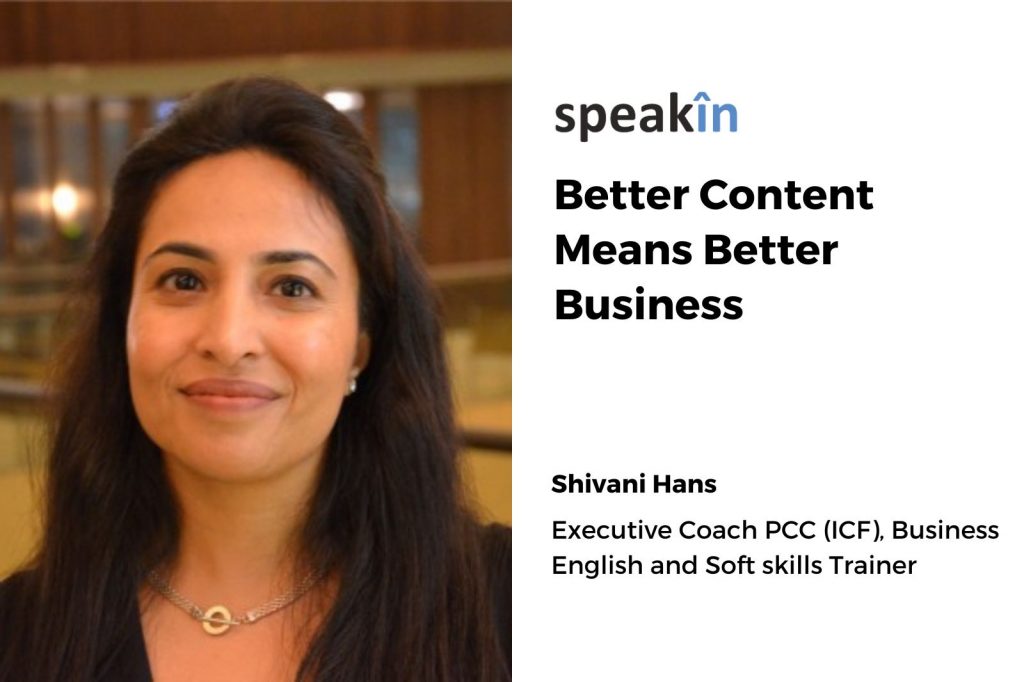Better Content Means Better Business

Better content means better business.
What is the most difficult skill in English? They say, listening, we can manage, we can speak and reading is something that we acquire, but writing is something which is something we always struggle with. So what is your biggest challenge? Basically, the biggest challenge is expression, you know. So there’s so much information in your head, but how do you express it in a concise manner? So a lot of times we start thinking so much, and have so much information that we get muggled up.
So as you said, writing concisely is something that a lot of people struggle with. There are so many ideas, and some of them say that they have trouble organizing their main idea, and one said that they use very long sentences.
Examples of business writing:
- Memos
- Formal letters
- Reports
- Emails
- Press releases
- Newsletters
- Bulletins
- and others…
Your Audience
First and foremost whenever you sit to write, you have to have this thing in your mind. Who is my audience? The audience is somebody who will define the tone of your writing, who will define what kind of writing you need to do, and they are the most important element of writing. So the question that you need to ask yourselves is, am I writing for my coworkers? That is who is on my team. Am I writing for my colleagues, probably in the same organization, but other business units? Or am I writing for my clients? Now, why does that make a difference? Because these are the people who will define the information that you need to dispense. If you’re writing to your coworkers, you can go with your jargon, you can go with your business words, and they will just understand what you mean. Colleagues from other business units, they might or might not. And the clients, probably, you have to tone down even more. And the level of formality also differs.
What is my audience expecting from me? And what do they think I am? Are they expecting me to be a subject matter expert? Are they expecting me to be an authority? Then they would need some detailed elaboration. Or, you know, is my audience already conversant with what I’m going to say? So for example, if you’re writing a legal memo, and it will go to your legal peers, you don’t need to go into details because they are already conversant with the legal terms, with the jargon. However, if it is written for the clients, you might need to elaborate. Understanding your audience will define how much information should go in and how much information needs to be structured.
Your Purpose
Next, is, what is my purpose? Why do we have business writing? Not for pleasure for sure. And there is always a purpose. We need business. We need some results. We need some good to come out of it. Nobody writes for pleasure. So, what do I want as a result? Am I writing to inform? Now, what could be writing to inform? I could be writing a sales report. So, I want to inform everybody about the sales numbers, whether, you know, we went up or we went down in the last quarter, what was the product, what was the perspective. So, this is just information that is being given for everybody’s consumption. So, that is the writing to inform. Then, I can also write to instruct. Now, when do we write to instruct?
Probably if it is a user manual, where a step-by-step process is explained for every employee to follow. Or it could be, you know, the new guidelines for COVID-19. So, these are the instructions that have come from HR. So, this is the writing to instruct. Then, we also write to persuade. Now, all of the time, even when we are writing to our boss, we could be doing a little bit of persuasion when we are writing to our clients, we are doing persuasion.
And so, the purpose is, am I writing to inform? Am I writing to instruct? Am I writing to persuade? And for all of these, the purpose is to transact. I’m doing some or the other kind of transaction. Now, if you look at instructional writing, whether I’m writing a user manual or if I’m writing a business memo, I am giving instructions that need to be followed. What is the purpose? They need to be easy enough to be followed.
There is no reason for me to write an instructional manual if everybody is going to come and ask me questions. If I have to go to everyone and do it for them, then it defeats the purpose. If I’m writing to inform you about the financial strategy or the minutes that I have written or recorded for some meeting, again, I want the people to be informed at the end of the day. Persuasive writing, the proposal emails, I don’t think it needs any more elaboration. And transaction, as I said, is done all the time.
And if you see that, you know, when I used these in the circles here, I made them intersect because there is a little bit of everything in every writing. When I’m writing an email to my boss, even when I’m informing him of something, I may be persuading him to do something, even if it is asking for leave. So I need to be very clear about the purpose. Why am I writing? Who am I writing for? That’s my audience. That will define how much to write. Purpose, why am I writing? What do I want at the end of it? Am I able to quench my audience’s thirst? Am I able to give them what they are expecting from me?
Planning
And once I have got the hang of it, I have to come to this because all of this requires planning. This is my favorite quote somehow. It says fail to plan is plan to fail. When you fail to plan something, you are setting yourself up for failure.
And the research says that whenever you sit to write, 55% of your time should go into planning and only 45% should go into actual writing. And believe me, if you spend 55% of your time in planning, that 45% is going to be a breeze for you. It’s going to be so easy. And what is planning? So planning is basically taking you back to your school days when we were taught the WH questions. Why? Who? What? How? When? Where? And that brings me to the question of why these WH questions.
And then one easy answer to the question that I posed is if you asked these questions to yourselves while planning, you are less likely to get emails asking the same questions. So that’ll save you a lot of time. People will not be confused when they read your email. They will not have any queries and that would mean better business. That would mean quicker business. So when you ask yourself, why am I writing? What do I want the audience to do? So when I get an email, if it is self-explanatory, I have no reason to write back. I will spring into action.
Therefore, these are the questions that we need to ask ourselves when we are before we start writing. So when we go back to planning, when I was planning this email, I wanted the response. I did not want to burn bridges. I wanted to make sure that, you know, I get a response, which is, soon enough. And yet at the same time, I will be doing business with them again, and often. So I do not want to have any hard feelings. So this all goes in planning. I’ve taken care of my audience because, you know, these two are very good business partners. And I have taken care of the purpose. And this is an email where I’m informing them about the outstanding payment. And I’m also to some extent doing some transaction. I’m telling them that, you know, I want it done.
The Structure
So, planning and structure. When we started, some of you wanted to learn about the structure. So planning tells us what to do. And structure tells us how to do it. How to structure my email? For that, we have this here.
BLADE. This is my favorite image because it’s sharp. It does the work. And so should be our writing, very sharp, very crisp. And I’m going to use these as a reminder every time when I structure my email.
Bottom Line: What is the bottom line? It does not matter whether it is an email or a memo or if it is any piece of writing. What do you want to convey? That’s the bottom line. To make the audience aware.
Action: What action do I want? What actions do you want in your email that needs to be included?
Details: Have I given all the details? When it was held, where it was held, who all were there, and why is it a big achievement?
Ending: Have I ended it?
So BLADE, bottom line, action, details, ending.
Who Am I?
The next thing about writing is who am I? That is the tone of my writing. I need to be aware that the people whom I interact with. You know, what tone should I take? If I’m talking to my clients whom I’m interacting with outside the office also, then I have to ensure that, you know, it’s a semi-formal, maybe friendly email. Whereas it’ll be more formal with the clients whom I do not interact with as much because the email, my writing has to be a reflection of who I am.
So if you look at this email, we have read this twice. So it is a formal email and even the way it is addressed, “Dear Ms. Grahams” – it shows a level of formality. And the same email, if I were to write to someone with whom I’m on more friendly terms, I will write like this, “Hi, Emily.”
The Subject
How do we decide what goes on in the subject? So the subject line has to be what your purpose is. The subject line will be always in line with what you want to convey. It can’t be vague. So as you said, what is the purpose of my writing?
4C’s of Writing
Clear, Coherent, Concise, and Correct.
Being Clear, Having Clarity
It’s very easy to say that, you know, you write clearly, you write coherently, you write concisely, you write correctly. Yes, I know all of that. But how do I do that? Let’s see that. Can you make this more clear? Please let me know as soon as possible. Please let me know by the end of the day. Yes, that is a very good way because I have been given a deadline. But what if Darren, I read this, not on the day when you sent it, then your end of the day and my end of the day would be different?
So I would, by clarity, I would mean specificity. Be specific. The more specific, the better it is. What do you want to convey? Here in this particular email, you wanted to convey that you needed the outstanding payment issue to be resolved, very clearly stated. It was even stated that you know, it could incur the late payment charges. And now another clarity is the deadline.
Being Coherent
Next, we have coherence. What is coherence? Coherence in a piece of writing means that the reader can easily understand. Coherence is about making everything flow smoothly. Now, how do we do that? Can anyone try to make this more coherent? If employees start feeling valued, they may become more committed to the organization. Companies make rules and policies for the employees. Whether they are the best for the employees or not is debatable.
To make it more consistent, okay, how? How can we do that? This is not one sentence remember, these are a couple of sentences that I need. Empathy in all matters is the cornerstone in keeping employees happy, whether achievable or not is debatable. So when I showed you the earlier slide, we talked about coherence. What does coherent mean? Anything we can make it flow smoothly if it isn’t flowing smoothly right now.
Here are certain transition words that can be used to ensure that your writing is always coherent. So whenever we are adding a point, in this one, we had a point that was different from the earlier sentence. So we used, ‘however’. So ‘adding’, ‘also’, ‘as well as’, ‘moreover’, ‘furthermore’, whenever you are trying to elaborate on something we can use furthermore. So that way, these are also called the words which will train the mind of the reader. So while reading, I will not get lost in the jungle of words. I will know that, okay, there is however, that means there is a change of thought.
There is furthermore, that means there is further elaboration. When I’m giving examples when I’m illustrating something, the company makes rules and policies ‘such as’, ‘for instance’, and ‘in the case’, all of these are devices called cohesive devices that can be used to make our writing more coherent. Then we have cause and effect ‘since’, ‘because’, all of these can come here. Then emphasizing, ‘on top of it’, ‘above all’, ‘in particular’, and ‘especially’ whenever we are trying to emphasize something. So sentences like, our sales team has been doing very well, and above all, and then we can add more feathers to their cap.
Being Concise
And next, we have conciseness, wordiness versus conciseness. As William Shakespeare said, brevity is the soul of wit. If we can convey what we want to convey in the shortest possible sentence and the, you know, as few possible words, then we have been able to do something which is worthwhile. And that is why we have another post by Thomas Jefferson which says the most valuable of all talents is that of never using two words when one will do.
Why? Why is wordiness something that is given so much importance? Why is conciseness valued? Why does everybody say that my writing needs to be concise? I’m trying to give them more information. Short attention span, yes, very good. Time is precious. Because I at least have never seen anyone, you know, curled up on the couch, you know, in the couch and reading and enjoying work emails and work memos and work writing, no one has time for that.
So, everyone, your audience is always running short of time. They have the attention span of a goldfish because they are in front of the screen all the time. So they are always scanning. What is in it for me? That is the thing, that is one thing that they want. So if your message is too long, it is quite likely to be pushed away, to be stacked away, and hence the value of conciseness. Replace weak words with strong ones, get rid of unnecessary words, use possessives, and avoid repetition. So do not use the same word to convey the same meaning. Don’t use two words to convey the same meaning.
Now, here are certain reminders on how to fix wordiness, instead of saying for the purpose of this we can use ‘to’, and we can use ‘for’. So we are replacing four words with only one. In order to, I know, I mean, these days, everybody says in order to have this in order for me to learn this. Yes, we have gotten used to saying all of that and I don’t mind saying it so much. But then when we are talking about concise writing, when we are talking about people who do not want to read long sentences and who get put off by long emails, every word counts, we are just going to go with our short and sweet ‘to’.
At the present time; ‘now’, ‘currently’. In the near future; ‘soon’. Because of the fact that; ‘because’. Due to the fact that; ‘since’, ‘because’. In the event that; ‘if’. In a position to, we are not in a position to answer your email right now. No, we cannot. End result, again as I said, we do not need to use two words when we can use one to convey the same sentiment. So just the result is enough.
Being Correct – Using Active Voice
Next is to use active voice. I know there has been a lot of debate regarding the use of active voice. Because there are some organizations that are in favor of passive voice. And I think for that, I would recommend that you go by what your organization wants. However, if you want it crisp if you want it to the point, and if you want it clear, I would recommend that you should go with an active voice. A mistake was made in tabulating sales for the third quarter. Now, this is some document which has been written. So probably, you know, if you’re referring to it, and if you’re writing, you feel very nice, because you have mentioned that there was a mistake which has been made. However, when you look at it after a few years, you wouldn’t know who actually did the mistake.
It sounds to me very evasive. And that does not have the clarity. So the finance team made a mistake in tabulating the sales for the third quarter. It’s not about pinning them down or blaming any team. It is just that an active voice brings in more clarity. And one of the elements of clear writing is clarity and specificity. So I would always say that, you know, unless and until your organization insists on the passive voice in certain matters, in writing, it should always be an active voice. Anyhow, if you get an email, which says that, you know, your email has been received, as opposed to we have received your email, you just feel that, you know, there is some person who’s sitting and whom you are interacting with. So that’s why the active voice.
So here we are with our 4 Cs of writing.
Clarity by being specific by using the active voice.
Coherence by following a structure, following the blade structure, and, you know, making sure that you use the transition words.
Conciseness by avoiding repetition and unnecessary words.
Correctness by paying attention to grammar and proofreading.
So spelling, punctuation, and grammar. There is no way around this. This is something that we have to be very, very careful of. So there are, you know, lists of some online proofreading tools. I have seen a lot of people being very addicted to Grammarly. And I have also found it to be quite useful, but there are others also if you want to have a look and try those. But please always, always, always prove free to your writing before you send it. So here we are at the end. And I’m going to leave with this thought that good writing is clear thinking made visible. And that’s what we have to remember.





